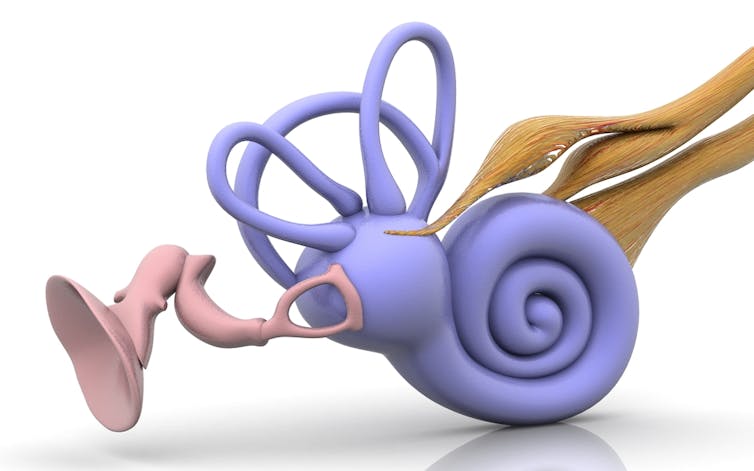
Why do you get dizzy when you stop spinning? - Finn, 7
Why does it look like the world is tilting when I spin around really fast, and then lie down? - Milosh, 7, Brisbane
Great questions, Finn and Milosh!
Your ears are really amazing. They help you hear and help you balance. And when you walk, run, jump and spin around, the parts of your ear that help you balance get really excited. Here’s what’s going on in your ears when you spin around (and when you stop).
Which way’s up?
Deep in your ears, past your ear drums, you have balance organs that tell you what is up and what is down. They also tell you that you’re moving, and even how you’re moving.
Three of these balance organs look like the inner tubes of a bicycle wheel. You can see these three tubes in blue in the picture below. These tubes tell you when you are moving and spinning.

The tubes are filled with fluid, like water. When you move your head, the fluid in the tubes begins to move. The moving fluid bends hairs on the top of hair cells that are also in the tube.
When the hairs bend in one direction, the cells become excited. The cells then send a message to your brain that your head is moving in that direction.
Amazingly, moving your head also moves your eyes. When you turn your head in one direction, your eyes move in the opposite direction. This is why you can clearly look at road signs in a bumpy car without the sign becoming blurry.
Read more: Curious Kids: Why do our ears pop?
I feel dizzy now
When you spin around and around on the spot, this moves the fluid in one of the tubes. The fluid in the tube moves in the same direction as if shaking your head “no”.
If you spin around really fast, the fluid in your ear moves really fast too. This is what happens when you first start to feel dizzy.
When you stop spinning, your head stops moving but the fluid in the tube of the balance organ keeps spinning. So now your brain thinks you are spinning in the opposite direction. This is what makes you feel dizzy again.
Your eyes then flick very quickly back and forth to the right and left too, even though your head is not moving anymore.
I think I need to lie down
If you lie down after spinning around really quickly, the water in the tube is spinning in the same direction as shaking your head “no”.
But now your head is in a different position. Instead of flicking right and left, your eyes flick up and down.
So, if you lie down after spinning really fast, the brain gets two messages about what your head is doing (going round and round, and lying down). These two messages join together and trick your brain into thinking the world is tilted.
Hello, curious kids! Have you got a question you’d like an expert to answer? Ask an adult to send your question to curiouskids@theconversation.edu.au
Rebecca Lim receives funding from National Health and Medical Research Council (NHMRC) and The Garnett Passe and Rodney Williams Memorial Foundation
This article was originally published on The Conversation. Read the original article.








